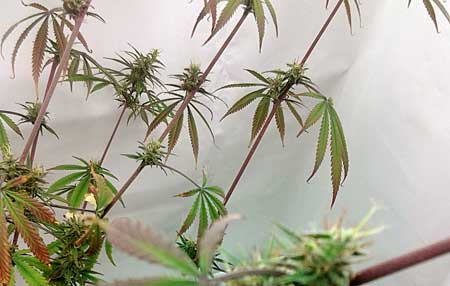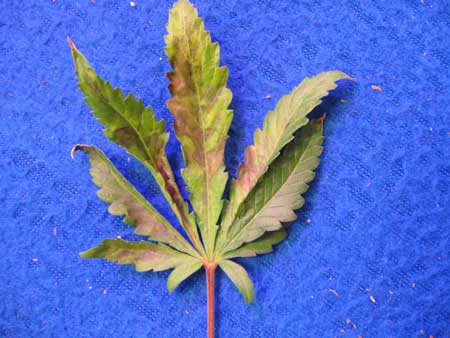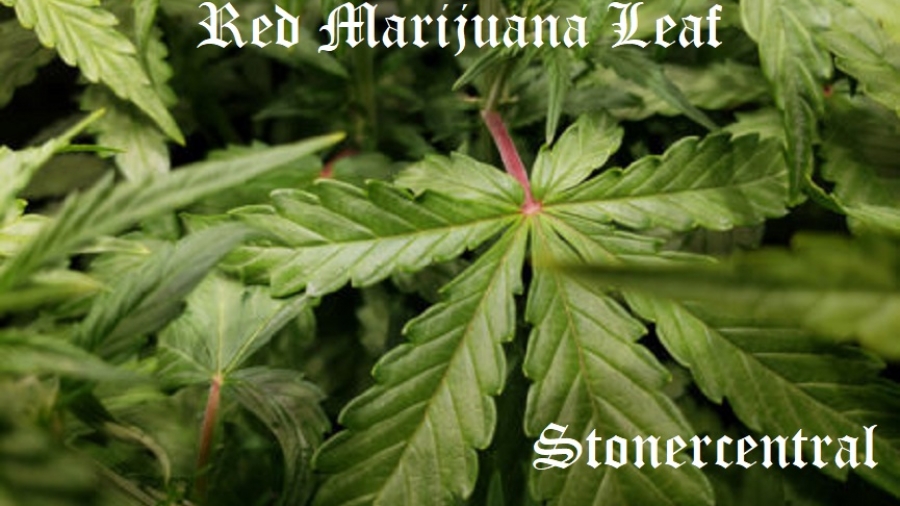You’re checking on your plants, things have been going pretty well. Then one day you notice a plant has bright red stems. Maybe there are other symptoms, too, like burnt leaf edges/tips, clawing/curling leaves, or yellowing.
A common cannabis plant symptom is red stems. What does it mean?
You love your plants, so what do you do? What’s causing your plant’s stems to turn red or purple?
There are a few different causes of red stems so I’ll share the most common ones below. Once you go through this list, you’ll be armed with more information to help keep your plants healthy and happy. Get the great yields and amazing bud quality you’re looking for.
Here are 6 common causes of red stems in cannabis plants:
1.) A “Sun Tan”
If a stem is totally exposed to strong direct light, it will often turn red, pink, or purple over time. If this is the cause, you’ll likely notice that any parts of the stem that are in shade will stay green. This is a defense mechanism by the plant to protect the stems from too much light. This type of red coloring is especially common with grow lights the produce a lot of UV light such as LEC grow lights (bonus: those same UV rays increase trichome production!).
With the rise of plant training techniques that expose bare stems, such as manifolding or defoliation, red stems caused by direct light is more common than ever.
In this case, you probably have nothing to worry about as long as you aren’t seeing any other symptoms and plants are growing fast and healthy.
This video shows how the stems/petioles lower in the plant are the typical green color. However, if you look closely at the stems higher on the plants, the tops have turned red wherever they’re getting direct exposure to light. Light exposure can be a major contributor to red stems.
2.) Genetics
Some plants (especially strains that produce purple buds or leaves) will naturally grow colorful stems. These stems may be reddish but typically look closer to purple than bright red. The purple color appears on stems all over the plant as opposed to just places that are getting light. There’s nothing to worry about in this situation, so you can just enjoy the purple.
3.) Temperature Fluctuations
Hot days and/or cold nights can trigger purple or reddish stems and leaves. If the discoloration appears the day after a cold night, the quick change in temperature may have caused the colorful stems. Typically temperature fluctuations cause stems to look purple, but sometimes the color can appear reddish.

These stems turned reddish-purple in response to cold night temperatures.
4.) Plant Stress
Cannabis plants react to stress in unpredictable ways. It may seem odd, but sometimes discolored stems are caused by seemingly unrelated factors like overwatering, bugs, or heat. That’s why it’s important to pay close attention to plants, use good watering practices and maintain a great growing environment when cultivating cannabis.
Learn how to water cannabis plants. For hydroponic growers, learn how to keep roots healthy. And watch out for bugs!
Many different types of plant stress can cause red stems. This plant with red stems looks like it is suffering from a nutrient deficiency, but the real cause of the symptoms is a planthopper infestation.
If the temperature of your growing environment seems extreme to you, it may be stressing out your plants. Each strain is different, but cannabis plants generally grow best in temperatures that are considered comfortable or slightly warm to humans. You should be able to put a hand where your plants are under the light and hold it there comfortably for 30 seconds. If it feels too hot for your skin, it’s likely too much heat for your plants. Learn how to create a perfect plant environment.
Red stems can also be triggered by keeping a grow light too close to the plants. Regardless of the temperature! Some strains are more sensitive to light stress than others, but just about all plants have a limit when it comes to light levels. It may be surprising, but a plant can experience stress from the light intensity even if the temperature is cool, similar to how a snowboarder can still get sunburned in the cold.
Since too much light can cause red stems and other symptoms of stress, it’s always a good idea to keep your grow lights at the distance recommended by the grow light manufacturer. LED grow lights especially are infamous for light-burning plants if kept too close (it’s common for growers to keep moving them closer since they run cool).
Keep grow lights the recommended distance away to avoid symptoms from light stress.
5.) Nutrient Deficiency Caused by Lack of Nutrients
If you look at your plant and you’re noticing that it’s pale all over, in addition to the red stems, that’s a sign your plant may simply need higher levels of nutrients overall. This is especially common if a plant has stayed in the same plant container for a long time without getting extra nutrients. If you’re growing in an inert soilless medium like coco, you may be giving too-low levels of nutrients. If you’re in a hard-sided pot, it’s also possible your plant is rootbound as opposed to out of nutrients, which means you should transplant to fresh soil. If you’ve been giving your plant nutrients in the water, this probably doesn’t apply to you, so skip to the next step.
The overall pale color alongside the red stems means this plant needs higher levels of nutrients overall. Grown in coco coir (which doesn’t naturally contain any nutrients), this grower needs to give higher levels of nutrients in the water.
Cannabis plants use high levels of nutrients compared to a lot of house plants, so growers typically add nutrients as part of the growing process. However, there are a few styles of growing cannabis that don’t require the use of extra nutrients at all.
For example, you can grow plants from seed to harvest in a big pot of richly amended, freshly composted (“alive”) soil that’s been formulated for a plant like cannabis. This technique works by providing nutrients via a method similar to nature. The composted soil contains a colony of microorganisms that break down organic material into nutrients, which your plant can use over the course of months. Known as a “just add water” grow method.
Where to get “just add water” soil? I recommend Nature’s Living Soil for a premade “Super Soil” concentrate. I’ve found them to be a great company that stands behind their product and they happily answer questions about how to use their concentrate for growing cannabis. Add it to regular soil or coco and the organic sources of nutrients slowly break down over months. If you follow instructions, you shouldn’t need to add nutrients in the water from seed to harvest.
These plants were started in nutrient-rich soil, but they used all the nutrients up before harvest. This caused the yellowing leaves and red stems.
6.) Nutrient Deficiency Caused by the Wrong PH
Is your pH too high or low? If you’ve ruled out all the above triggers, there’s a strong chance the red stems are a sign your plant has a pH-based nutrient deficiency (or the beginning of one). Nutrient deficiencies that can affect red stems include Magnesium deficiencies and Phosphorus deficiencies. If you’ve been giving your plants nutrients, these deficiencies are typically caused by incorrect pH.
A nutrient deficiency is especially likely if your stems are bright red (not purple) all over the plant, and the coloring doesn’t seem affected by light exposure. You may also see other symptoms of deficiencies such as brown edges, curling leaves, burnt tips, yellowing, and more. Luckily, nutrient deficiencies caused by incorrect pH are easy to get rid of.

Red stems can be caused by nutrient deficiencies caused by too-high or too-low pH. This leaf is suffering from multiple problems including red stems.

An execllent post from you, all useful in filling up my brain up with useful information. I’ve also taken the time to share
this on Twitter 🙂
I use cold water on purpose after buds are done growing and start to swell because I’ve noticed it helps dense them up, tops turn snow white and the purple color looks great. But I have seen it happen on rootbound plants and nitrogen toxicity or if the room temp flexes drastically from say 80 to 60. It can cause issues if not careful. So I would have to agree that the purple is a sign of stress, some strains do get purple but this is still in veg something is up I would definitely go with rootbound too.